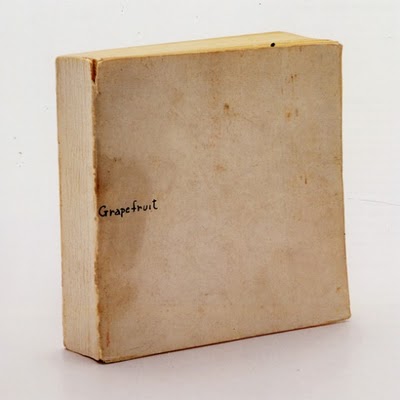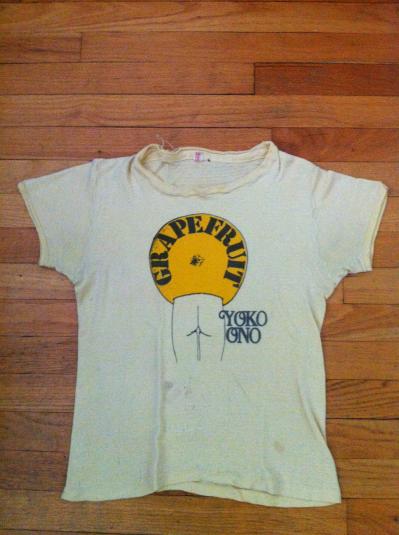
It was expanded for its 1970 reprint to include Film, Dance, and Architecture Pieces, as well as a Letters section, which publishes correspondence with gallerists and Ono, and Information, to provide details on when, where, and how Ono herself performed the event scores.Ĭalling upon the four elements, water, air, sky and earth, the event scores occasionally involve obtaining mundane materials such as a canvas, glass, a telephone, stones, clothing, etc. The original 1964 edition featured instructions, poems, and drawings categorised under five headings Music, Painting, Event, Poetry, Object.

Titled such because Ono considered herself to be a hybrid of Japanese and American, just as the grapefruit is a lemon and orange, Grapefruit is composed of what the fluxus movement dubbed “event scores” – a performance script which consists of actions as opposed to speech. They were my therapy in a way” – Yoko Ono “Many of the Grapefruit pieces were written for my sake, to save me. Following the instruction from Ono to “Burn this book after you’ve read it”, Lennon wrote: “This is the greatest book I’ve ever burned.” Existing at the axis of these is her 1964 book, Grapefruit – described as a “one of the monuments of conceptual art of the early 1960s”. Originally released as an edition of 500 copies while Ono was back living in Tokyo with her second husband Anthony Cox, Grapefruit was reprinted in 1970 with an introduction from Lennon himself. While Ono never claimed loyalty to a particular movement, she has long been associated with fluxus and conceptual art – the former which embraced change (‘flux’) as an important part of life and ultimately laid the groundwork for the latter. Although recognised as an artist in the mainstream press thanks to the pair’s 1969 Vietnam War protest, Bed-Ins for Peace, which was performed in both Amsterdam and Montreal, Ono had in fact been independently creating groundbreaking art for well over a decade. The pair married in 1969 and by the time The Beatles had broken up in the mid-70s, any of Ono’s artistic contributions had been overshadowed by her new role as the woman who broke up The Beatles. On a trip to London in 1966, Ono met John Lennon when he attended her exhibition opening at the Indica Gallery. Having withdrawn from her studies at Tokyo’s Gakushuin University, she applied for New York’s Sarah Lawrence and soon found herself entwined with New York City’s burgeoning art scene. In 1953, a 20-year-old Ono moved to New York City. So we had our conceptual dinner and this is maybe my first piece of art.” So, I realised even then that just through imagining, we can be happy. What kind of dinner would you like?’ And, he said, ‘Ice cream.’ So, I said, ‘Good, let's imagine our ice cream dinner.’ And, we did, and he started to look happy. “I said, ‘OK, let's make a menu together. Speaking to the Guardian in 2013, she described how, after being evacuated in the aftermath of the heavy bombing of Tokyo during World War II, Ono’s brother was “really unhappy and depressed and really hungry because we did not have very much food.” Her solution was to turn to their imaginations.

However, it’s Yoko Ono – whose late husband John Lennon once described as “the world's most famous unknown artist” – who is one of its most important, and pioneering, associates.īorn in Tokyo in 1933, during the frightening years of World War II, Ono took refuge in art as a child and has cited starvation as the spark for her earliest artistic contribution. Writing in The Art Newspaper in 2009, Ben Davis levelled, “Conceptual art is no different from ‘traditional’ art: There is plenty of interesting painting and sculpture today there is also plenty of boring, derivative painting and sculpture.” Artists whose conceptualism followed in Duchamp’s footsteps are also some of the most boundary-pushing artists in history, from John Baldessari to Barbara Kruger, Jenny Holzer, and Yayoi Kusama.


As a practice based on ideas rather than materiality, aesthetics, or technicality, it’s understandably the Marmite of the art world. Since the introduction of Marcel Duchamp’s “Fountain” in 1917, which – despite being labelled by the artist himself as a readymade – is arguably one of the first examples of conceptual art, the movement has long been misunderstood or denounced entirely.


 0 kommentar(er)
0 kommentar(er)
